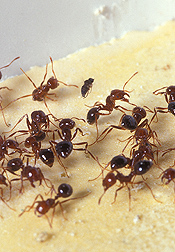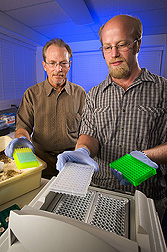Message to Imported Fire Ants: Watch Out!
They can be anywhere: parks, cow pastures, hay bales—even inside electrical boxes—and almost any way you look at them, imported fire ants are a problem for people and their animals. Grazing cattle are susceptible to stings from these nasty characters, and people just happening upon them can also come under painful and sometimes life-threatening or fatal attack.
Since arriving in Mobile, Alabama, in 1918, imported fire ants have made their home on more than 320 million acres in several states and Puerto Rico.
Their aggressive behavior, potent stings, and large numbers—10 to 30 million per acre—cause significant problems. Billions of dollars are spent each year to prevent and repair their damage and cover medical and veterinary expenses.
“The harm they cause to agriculture totals over $67 million a year in Texas alone,” says Robert Vander Meer. He leads the Imported Fire Ant and Household Insects Research Unit at ARS’s Center for Medical, Agricultural, and Veterinary Entomology (CMAVE) in Gainesville, Florida. The ants also build mounds that damage farm equipment and mowers.
Since 2001, CMAVE scientists have been leading an areawide project aimed at slowing down and turning back the spread of imported fire ants. Participants include USDA’s Animal and Plant Health Inspection Service, state agencies, and land-grant universities. This project brings together newly developed, self-sustaining biocontrol with classical toxic bait technology in an integrated approach to fire ant control.
|
|
Deadly Dive Bombers
One tactic now in use is the release of tiny insects called “phorid flies.” South America has about 20 phorid species that attack only fire ants. A phorid fly will pursue an ant and lay a single egg inside its body. The immature fly, or maggot, burrows into the ant’s head, where it grows without killing its host. Then, just before reaching maturity, the maggot eats the inside of the head and causes it to fall off. The ant’s head becomes part of the pupal case from which the little fly emerges.
Two phorid fly species have been established in the United States: Pseudacteon curvatus and P. tricuspis. A biotype of P. curvatus that attacks small black and hybrid fire ants now occupies most of the infested areas of Tennessee and big portions of northern Mississippi and Alabama. A second biotype, which attacks small red fire ants, has spread more than 80 miles from initial sites in north Florida and is established in eight states. P. tricuspis now covers most of Florida, southern Georgia, and large portions of six other states.
An additional decapitating fly, P. obtusus, awaits field release later this year, and another, P. cultellatus, is being evaluated in quarantine.
|
|
Dispersing Deadly Pathogens
Tiny protozoan parasites that take up residence within the cells of hosts also have potential for controlling imported fire ants. One of them, Thelohania solenopsae, is being investigated by CMAVE scientists David Oi and Steven Valles and by Juan Briano at ARS’s South American Biological Control Laboratory (SABCL) in Hurlingham, Argentina. They use new PCR (polymerase chain reaction) detection methods developed at Gainesville to follow the spread of the parasite within fire ant colonies. Worker ants transfer T. solenopsae spores to the queen, possibly through food. Infection reduces the queen’s egg laying, so colonies die out.
“Though we found that natural field infections of T. solenopsae were more prevalent in fire ant colonies with several queens, we also confirmed that single-queen colonies were susceptible to infection,” says Oi.
Working with SABCL scientists, the CMAVE team successfully transmitted another fire ant parasite, Vairimorpha invictae, to uninfected fire ant colonies for the first time in 2004. It destroyed the ants, but researchers had to prove it would infect only imported fire ants before it could be released from quarantine. By 2006, those quarantine studies—in Gainesville and Argentina, with cooperators from Clemson University—had shown that V. invictae doesn’t infect non-fire ants or other arthropods collected in Argentina.
“This is important because it shows that this pathogen may also be suitable for release in the United States with little or no risk,” says Oi.
Viral pathogens are also being brought to bear on the problem. Valles and his colleagues discovered the first virus known to infect red imported fire ants—Solenopsis invicta virus-1. It’s been associated with the deaths of immature ants. Infected ants don’t usually show symptoms unless they encounter certain stressors. Then, viral replication increases within them, and their brood later dies.
“We want to better understand these stressors and the molecular triggers that cause this shift from an asymptomatic to an active, lethal infection,” says Valles.
When Two Become One
Just as insects evolve resistance to pesticides, they may also evolve in response to ecological pressures. CMAVE entomologist DeWayne Shoemaker is researching population and evolutionary genetics of imported fire ants.
When S. invicta and S. richteri—the red and black imported fire ants—come into contact, they often mate with each other and form hybrids. If hybrids persist, then a gradual change may occur in the distribution of the species over a geographical area. Currently, S. richteri has a very limited distribution, whereas hybrid fire ants occupy a vast area in the southeastern United States.
“Extensive genetic data suggest that the two species don’t hybridize in South America, even though their ranges overlap considerably,” says Shoemaker. “So what factors have led to hybridization between the two species after coming to the United States?” Shoemaker plans comparative studies of the two, both here and in South America, to address this question.
“The areawide fire ant control project is showing the effectiveness of integrated management techniques while improving farm worker safety, reducing mechanical and electrical equipment damage, and lessening pesticide use,” says Vander Meer.
“It’s estimated that the biocontrol agents we’ve released currently occupy more than 100,000 square miles and benefit more than 20 million people.”—By Sharon Durham, Agricultural Research Service Information Staff.
This research is part of Veterinary, Medical, and Urban Entomology, an ARS national program (#104) described on the World Wide Web at www.nps.ars.usda.gov.
Robert K. Vander Meer is with the Imported Fire Ant and Household Insects Research Unit, USDA-ARS Center for Medical, Agricultural, and Veterinary Entomology, 1600 S.W. 23rd Dr., Gainesville, FL; phone (352) 374-5855, fax (352) 374-5818.
"Message to Imported Fire Ants: Watch Out!" was published in the September 2007 issue of Agricultural Research magazine.









